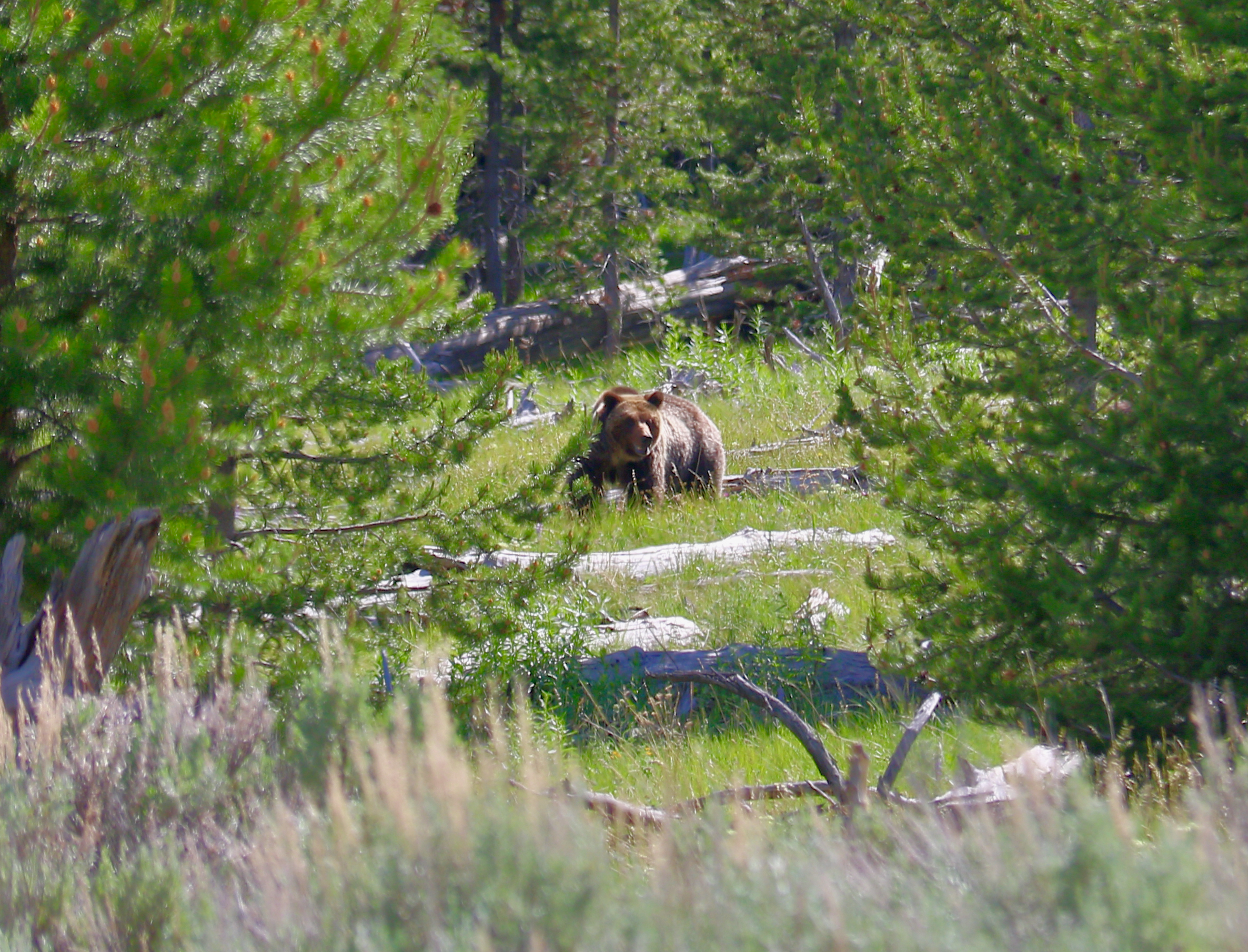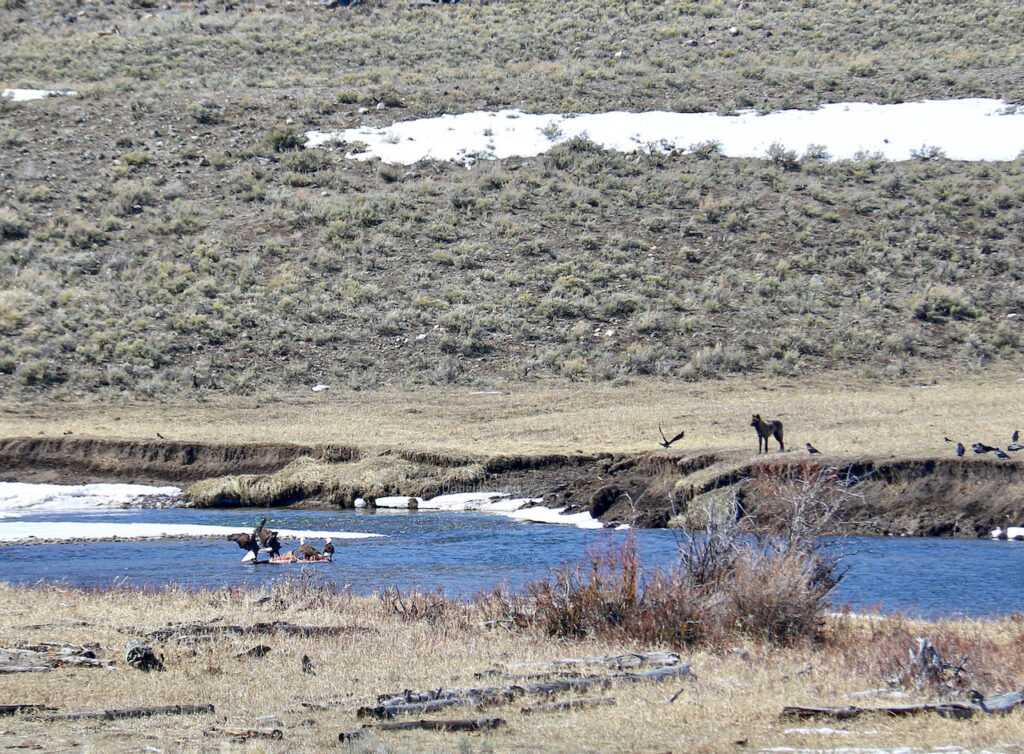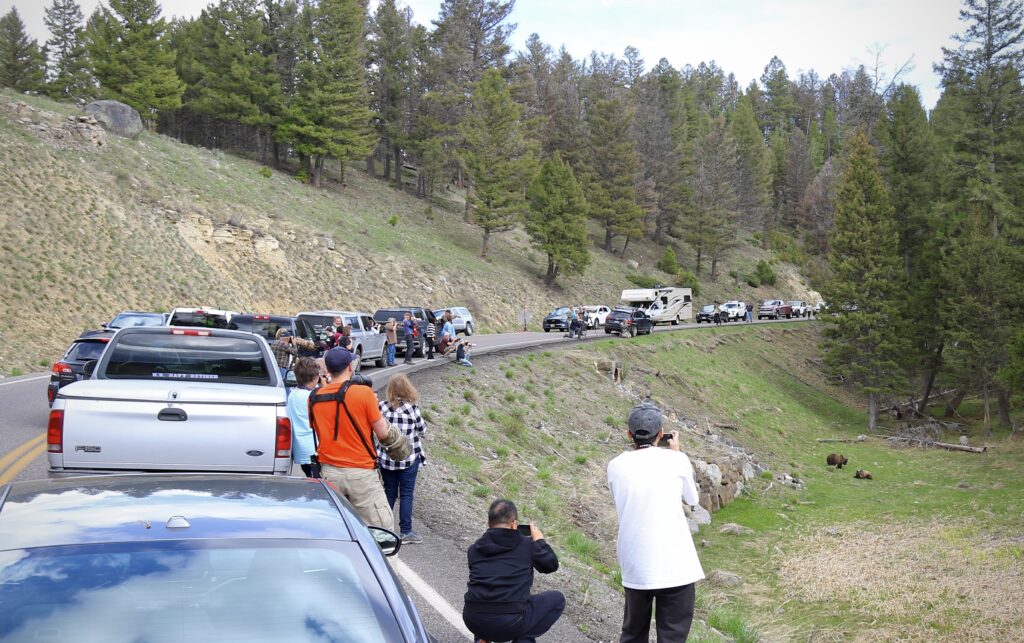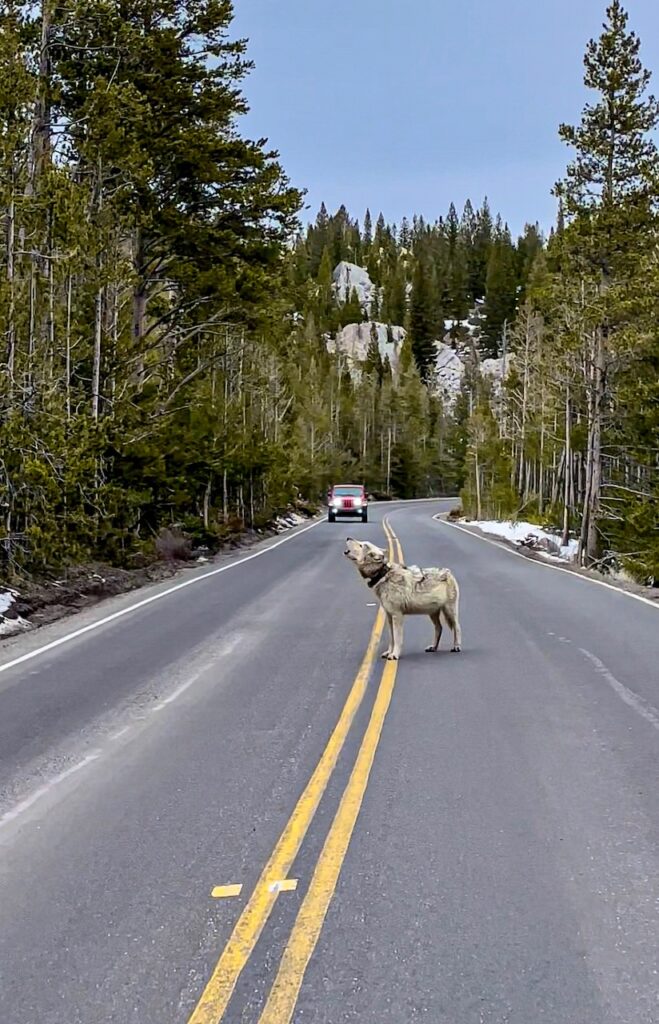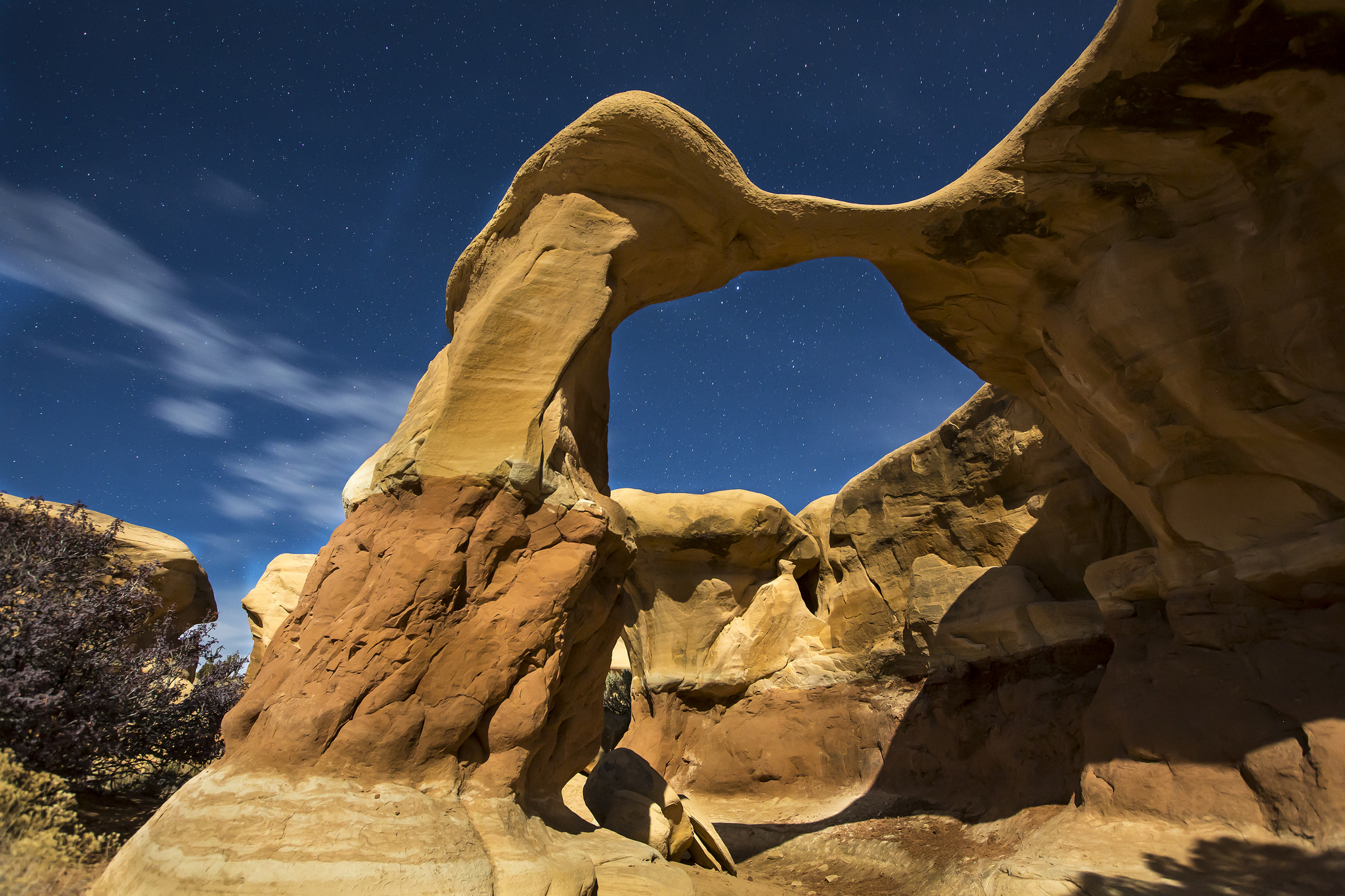There is a big question when wildlife watching in Yellowstone: Should you chill and wait for the animals to become visible at a known location, or should you hop back in your car and seek them out?
A standard Yellowstone scenario is as follows: You are driving in the park and you come to a pullout with people looking through binoculars and spotting scopes. You decide to stop and get out of the car, hoping to see what they all see.
When you reach them and ask what they are looking at, they say something like “There were wolves out in the distance a little while ago, but we can’t see them now.”
They continue, “but they may be active again soon.”
Yellowstone’s huge and wild lands give you this dilemma daily. Do you trust in your patience, waiting for the wildlife to come back into view, or do you take matters into your own hands and test your luck by driving around the park?
Fans of both sides swear by their methods, each with stories and reasons to back them up. I tend to not wait around, as the park is huge and there are so many other experiences waiting. I have had amazing luck doing this and swear it is the best way to go. However, others I know prefer to stay put and wait and they have also had amazing viewings.
Exploring this debate isn’t just about spotting wildlife—it’s about how we connect with nature and what kind of adventure we crave when visiting Yellowstone National Park. I do wish I had a clear answer for you, but the best I can do is give you some pros and cons of each and wish you the very best in what you choose to do.
Before I get into those, I quickly do want to let you all know that I have written a wildlife-watching guidebook to Yellowstone National Park based on 35+ years of experience. I can’t recommend picking up a copy before your trip, not only to help you find animals but to also familiarize yourself with the park and know what to expect.
Pros of Driving Through Yellowstone Searching For Wildlife
Flexibility and Freedom
Driving allows you the freedom to adventure around Yellowstone at your own pace. This flexibility is especially advantageous for those who want to cover more ground and witness the park’s various geothermal features and scenic landscapes. If your timing and luck are right, you’ll see plenty of wildlife, including bears, wolves, and maybe even a moose or an otter.
Yellowstone Luck
Yellowstone’s wildlife is known for its unpredictability. Driving increases the chances of wildlife encounters, with animals often appearing unexpectedly along the roadways. This has happened to me quite often. Most notably, a few summers ago I was debating whether to wait to see wolves emerge over a hillside or to drive home. I decided to drive and near Mammoth, had a lone wolf walk out into the middle of the road, sit down, howl, and then walk right next to my vehicle. I had a friend who stayed with the group and they ended up not seeing anything. All of the park’s advice and wildlife experts can tell you when and where you should see something, but there are always outliers and unique moments to be had.
See Yellowstone’s Diverse Habitats
By driving through different regions of the park, visitors can experience the diverse habitats that support various species. Each area offers a unique chance to spot different wildlife from grassy meadows to dense forests. You’ll also be able to stop at all of the scenic wonders you desire since you’ll be near them. If you have a limited amount of time for your visit, driving around will get you everywhere you want to go and then some.
Cons of Driving Through Yellowstone Searching For Wildlife
Traffic and Crowds
Yellowstone’s popularity can lead to traffic congestion, especially during peak seasons. Heavy traffic may hinder wildlife sightings and diminish the overall experience. You may decide to leave a spot where people are waiting and drive on, only to be at the tail end of a long bison jam, without even seeing the bison. Popular attractions and viewpoints may have limited parking, making stopping and observing wildlife without disrupting traffic flow challenging.
Time In Car
Chances are, if you decide to drive around looking for wildlife, you’ll be in the car a lot. Suppose you were to drive from Mammoth to Lamar Valley, from Lamar to Tower and Canyon, through Hayden Valley, alongside Yellowstone Lake, up to Old Faithful, through the Geyser Basins, and back to Mammoth with no stops. In that case, it will take you just under 8 hours if you are driving the speed limit. The route is just under 200 miles in length and you will more than likely be delayed for any number of reasons. Again, this does not include any stops or delays, which will occur.
An Unlucky Day
While putting in miles driving around the park does give you the most opportunity to see wildlife around the park, it doesn’t always work out that way. Sometimes you will drive all the roads and not see much of anything. While this may be a disappointment, it happens and it is just the way the park is sometimes. On a day like this, you may miss all the animals by a few minutes, or it could just be a slow day in the park.
Pros of Sitting and Waiting at Wildlife Hotspots
Enhanced Experiences
Choosing specific wildlife hotspots and sitting patiently allows for more focused and prolonged observation of animals. This approach is ideal for wildlife enthusiasts and photographers who capture intimate moments. You will also be able to slow down, seeing more than just the large wildlife in the area. As you sit and wait, you’ll see birds fly by and smaller animals scamper around. You’ll also get a better appreciation of the landscape all around.
Expert Guidance
Many popular wildlife viewing areas have knowledgeable park rangers, guides, or wildlife-watching enthusiasts at them, especially if there is an animal nearby. They can help provide insights into animal behavior and assist in identifying different species, as well as give you some good information about where else/when you may be able to see the more popular wildlife. More often than not, if there is something visible, even far off in the distance, there will be people who have their spotting scopes set up and will let you look through it to see animals far away.
Reduced Environmental Impact
Sitting and waiting minimizes the disturbance caused by vehicles, contributing to a quieter and more natural environment for wildlife. You are also emitting less exhaust into the air (if you keep your car off when you wait), helping to reduce traffic on the roads, and potentially lowering the stress levels on wildlife around the park.
Cons of Sitting and Waiting at Wildlife Hotspots
Limited Experiences
Sitting and waiting restricts the ability to experience the park extensively. Visitors may miss out on other sights and natural wonders by dedicating significant time to a single location. If you choose to wait for wolves or bears to emerge from an area where they were previously spotted, you may wait there for multiple hours without a sighting. Because of this, you may not have time to see the Grand Canyon of the Yellowstone River, Grand Prismatic, Norris, Old Faithful, or hundreds of other incredible landmarks in the park.
Unpredictability
It can suck just to sit and wait. I wish it weren’t the case, but many who sit and wait for an animal to emerge are left without seeing anything. Waiting for extended periods without any significant encounters can cause regret and even frustration, as you will have missed out on many other potential experiences. I have sat and waited for a grizzly to emerge from a forest, only to learn that another grizzly with cubs was spotted a few miles away.
Lack of Amenities
99% of the time, an area where you are sitting and waiting for an animal to become visible will not have any amenities whatsoever. There will be no food, no water, and most importantly, no place to relieve yourself. You could leave for a few minutes to drive to a nearby pit toilet, but you may lose your spot at the pullout, and/or you may miss the animal.
Ultimately
The choice between driving through Yellowstone or sitting and waiting at wildlife hotspots depends on personal preferences and priorities. For a balanced experience, consider a combination of both methods, allowing you to see the park’s diverse landscapes while maximizing your chances of encountering its incredible wildlife. I do this by setting a time limit as to how long I will wait. I always expand it a bit, but I can at least say that I gave myself a good chance to see the animals. You can also always drive back to the area later.
Yellowstone’s wildlife dilemma underscores the delicate balance between sightseeing and patience, making every visit a unique and rewarding adventure. There are no wrong answers. You will see wildlife and you will miss seeing wildlife in seconds or minutes. That is the way of Yellowstone and it is important to accept that your day in the park will be what it is. No matter what, you’ll have a memorable and wonderful day in Yellowstone if you try.
Become a Wildlife Watching Expert in Yellowstone
Embark on a captivating journey through the untamed beauty of Yellowstone National Park with my guidebook, “Wildlife Watching Yellowstone.” Immerse yourself in the awe-inspiring landscapes and learn the secrets of one of nature’s greatest spectacles. This guide is your passport to a world where bison roam freely, grizzlies majestically traverse the terrain, and elusive wolves play their part in the delicate balance of the ecosystem.
Whether you’re an avid nature enthusiast or a first-time explorer, this meticulously crafted guidebook will unlock the wonders of Yellowstone’s wildlife, offering insights into their behavior, habitats, and the best spots for unforgettable encounters. Let the pages come alive with vivid descriptions, stunning photographs, and expert tips, inviting you to witness the magic of the natural world in all its glory. Seize the opportunity to create lasting memories and deepen your connection with the wilderness – “Wildlife Watching Yellowstone” is your key to unlocking the wonders of this iconic national treasure.

